Above: Shibuya Crossing at Night
The first Japanese eye-opener was at the Narita terminal having our Japan Railpass validated. The Japanese are sticklers for the correct process and we found we had ten minutes before closing time to book all the seats for all our train travel for the next two weeks. The young lady dealing with us spoke flawless English, though still apologised for its inadequacy, and was as fast as a bullet train, her fingers flying over the booking calculator all the time laughing. We were done in 10 minutes and the door was softly closed behind us on the dot of 8.30. Efficiency+exactness+laughter=perfection!
Our hotel is 13 levels high but looks as wide as a little old Balmain terrace – same goes for the room we have. Tiny, and for the first time in my life I got claustrophobia. The window doesn’t open, the aircon seems to have only hot or cold, there is one metre between the wall and the bed for all the furniture and there is no room on the other side of the bed nor at the foot both of which are bound by wall. But the bathroom, though still minuscule, is superbly organised and everything works perfectly.
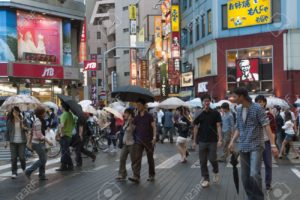
We are staying in Ginza, an old geisha district, but now slick hip and stylish with an amazing wide thoroughfare through the middle called Chuo-Dori with every smart world brand in colourful vertical signs on all the sleek up to the minute towers with glass fronts that line both sides of the street. On weekends it becomes a pedestrian space and most surely be the most elegant shopping street anywhere. We dived out of the rain into the outside lobby of the great Mitsukoshi department store, but found the doors closed waiting for the 10.30 opening and crowds of people waiting to be admitted. On the stroke of 10.30, two elegant female assistants stepped forward from inside the great glass doors, opened then and stood back while the shoppers teemed in. As they did every assistant standing In front of their counters bowed to the waist over and over again as the shoppers swept past. Sally of course pulled out her phone to snap the sight, and then we headed for the basement levels where the arrangements of every conceivable food delicacy have to be seen to be believed. Most of it has to be regarded as art as much of it doesn’t even look like food, or not food you feel you should sully by putting it in your dirty mouth. Some of it was quite grotesque – after all, it was Halloween. After an hour or more of entranced gawking, we agreed to come back in the evening and buy select delicacies for dinner back in our cell.
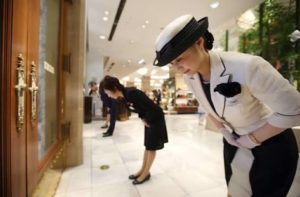
Another amazing Tokyo experience is the trains; not the bullet trains, that’s yet another. No I mean the subway and the surface trains of the so-called JR line (Japan Rail). Between them there must be at least 30 lines that intersect the Tokyo metropolitan area. The map is a riot of colour as every line is named and colour coded. They all cross each other endlessly and to get anywhere you have to master the impossibly complicated map. Verging on the Aspergers spectrum as Sally suspects, this is easy meat for me and after an hour or two of intense study, I feel I am an expert and guide a hopelessly lost wife with confidence up and down stairs, escalators, up lifts, down corridors, across concourses, into tunnels, finding the right exit (up to 20 or more for larger stations) and onto multi-coloured trains. During our five days in the city, I believe we were either on or getting to trains or getting off to find another train for more hours of the day than any other activity. But anyone fearing it will be too hard, don’t worry, every sign is in English as well as Japanese.
The hype these days about Japan is the food, asserted by many experts including Tetsuya Wakuda, who might just be a bit biased, that it’s the world’s best, combining Japanese finesse with all the great European and other cuisines. But being a musical traveller, I was determined we should visit Tokyo’s premier concert hall, the Suntory Hall, built by an industrial baron. For many years it has welcomed the great orchestras of the world whose world tours always include Suntory Hall.
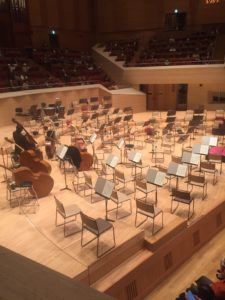
Long before we left Sydney, I looked up the website to see what concerts were scheduled for the time we would be in Tokyo, prepared to schedule our trip around good prospects. As luck would have it a concert with the NHK orchestra, Japan’s best, with Christophe Eschenbach was scheduled but on the internet from Australia, no seats could be booked. I contacted Ben Ross, son of Fe and Don and a Tokyo resident. He reported it was sold out but his wife Naoko resourcefully got on to an online auction and found us two excellent separate seats. The hall is quite hard to find and our pocket wifi took us on a merry dance to get us there from the subway. Inside it is spacious and clad in elegant pale timber. Eschenbach offered an all Brahms concert – symphonies 4 and 1. The elderly Japanese gentleman beside me told me the Tokyo audience can’t get enough Brahms, and the orchestra clearly lapped it up – the performances of both symphonies were about the most incisive AND expansive I’ve ever heard. A large string section of 60 gave a deep rich sound with strong exact rhythms and perfect security at all times. The typical classical wind and brass sections led by a superb first flute for the gorgeous sad solo in the last movement of the 4th, were all you could want. After a lifetime of listening on and off to Brahms, I was struck by the large part in both pieces for the double bassoon who worked like a Trojan all night, belatedly recognising the origin of the characteristic grumbly sound in all his orchestral music. The concert came to a thrilling conclusion when in the final thrilling bars of the 1st, strangely played after the interval, with the whole orchestra going fff, the timpani, during fantastic ffff rolls, lost one of his sticks, which luckily fell on the drum and it was back in his hand for the final flourish in an instant!
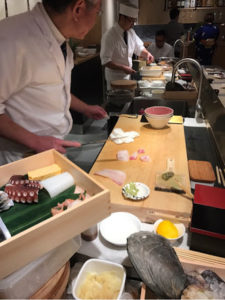
To cap a wonderful evening, as we caught the subway back to the hotel, we decided the afternoon snack wasn’t enough and dropped in at a smart looking sushi restaurant a few doors up from the hotel. We sat at the counter in front of one of the two chefs and watched transfixed as he sliced chopped, squeezed and turned the variegated seafood into incredible shapes and then placed them in front of us. The tastes, colours and textures were divine, incredible plus a Pouilly fuisse chardonnay to wash it down. We left an hour later agreeing it was the most delicate and flavoursome meal we’d ever had – The Golden Rice Sushi.
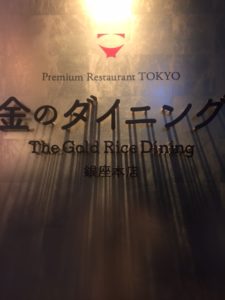
Scrolling through the internet, Sally came across an organisation called Tokyo Free Guides that offers free guiding for tourists. She applied online and immediately had a response from a lady of a certain age called Ryuko – maybe in her 60s. Sally asked I’d she would b available the next day, Friday, and the deal was done. Ryuko agreed to guide us from 10 to 3 pm and we chose the Ueno/ Asakura district to the north of the city, full of older precincts, parks and cultural institutions. It’s a very impressive arrangement and the only cost to us was her bus or subway fares and lunch. She spoke perfect English, has done this for years and sees it as a sort of civic contribution as well,as being a pleasant way to get to meet visitors to her city. She can answer any question you throw at her and you takes you at a cracking pace anywhere you want. She took us to a nice restaurant for lunch high up over Ueno’s busy streets. Over lunch at our questioning she explained their very practical booking system which allows the volunteers to select guests they think they would like. For us the whole experience was most enjoyable and a great way to learn in a more intimate way about Tokyo. Another big thumbs up for Japanese generosity.
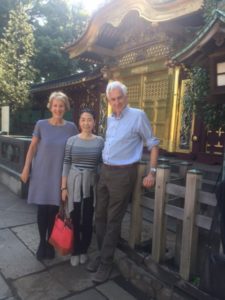
It was Ryuko who recommended the first ancient garden we visited on our Japan sojourn – she also guides in two or three of them. This is one of the most revered – originating 400 years ago but in its present state benefiting from the generosity of the Mitsubishi organisation. Unlike many, this garden is not integral to a shrine or temple but is redolent of the old Japanese virtues of peace, order, and integration of spirituality with nature. Equivalent in size to a large city block, it is based around a lake with three small islands in the middle. Gnarled ancient Japanese pines, many propped up with wooden poles surround the lake. Special stones, or rocks, have been brought from all over Japan to border the garden in seemingly haphazard ways, yet like every beautiful vista in the garden, the aesthetics are so elegant that you can’t help feeling that human intent has merged with nature. The maple and fruit trees, in contrast with the pines, are turning golden, pink and burgundy, though we are told autumn has come late this year and it will be mid to late November before the full autumn glory is reached.
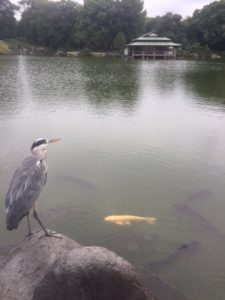
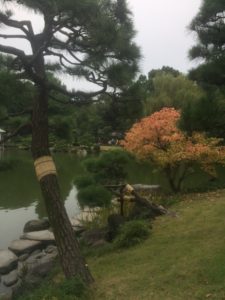
One day, the first really clear sunny day we had, we decided to do a day trip up to the Hakone district where there are beautiful lakes, a cable car over the mountains and the best views to be had of Mt Fuji. All this turned out to be true and in many ways it was a lovely scenic day, but travellers beware: the travel time on the bullet train, then the oh so slow bus, then the pirate ship cruising the lake, the cable car (called the Hakone ropeway), then the interminable straphanging funicular down the mountain, then two more trains to get back to Tokyo – all this meant that 90% of the day was in crowded conveyances, much of it standing.
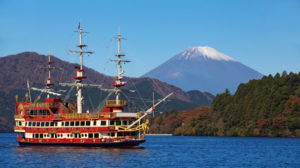
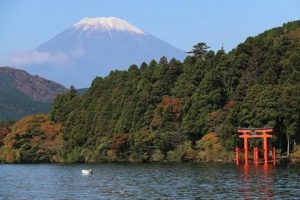
Eating the superbly prepared and presented food is one of the most easily appreciated delights of discovering Japan. Only once were we disappointed during our Tokyo stay. Our last day was solidly wet all day and included a rather gloomy wander ( with another voluntary guide) through the Imperial Palace gardens under umbrellas. I had booked a special treat for dinner at one of Tetsuya’s top recommendations, the world famous teppanyaki Udai Tei – he spent half a page extolling its mind-blowing virtuosity. We set out in the pouring rain to walk 20 minutes to our destination, Sally very dubious about the whole idea. I realised it would be costly so steeled myself to as much as $300 for the evening. It was hard to find but find it we did like drowned rats, and were greeted at the street by a charming hostess. A glance at the menu options at the door showed the cheapest option would cost $350 each, not including drinks. I never made a faster decision – we were off into the night before Sally even knew what was happening! Eventually, even wetter, we found a lovely modern/ traditional place where we had a delicious multi-course dinner for about $80 each, a far better way to cap our Tokyo stay.
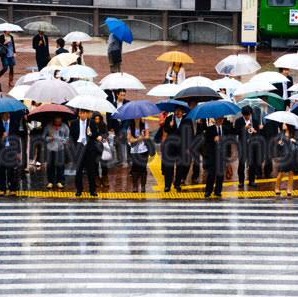

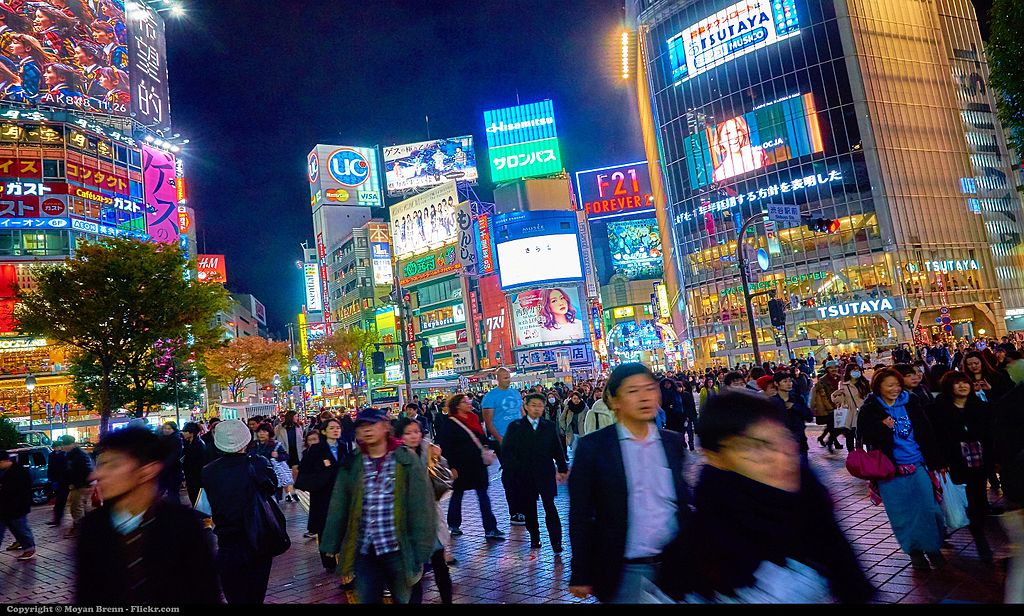
Wonderful stuff AJ, I’m so please you have both paved our way with insites. I suggest you post Sally’s three things you must do before you leave Aust. Very best. xo